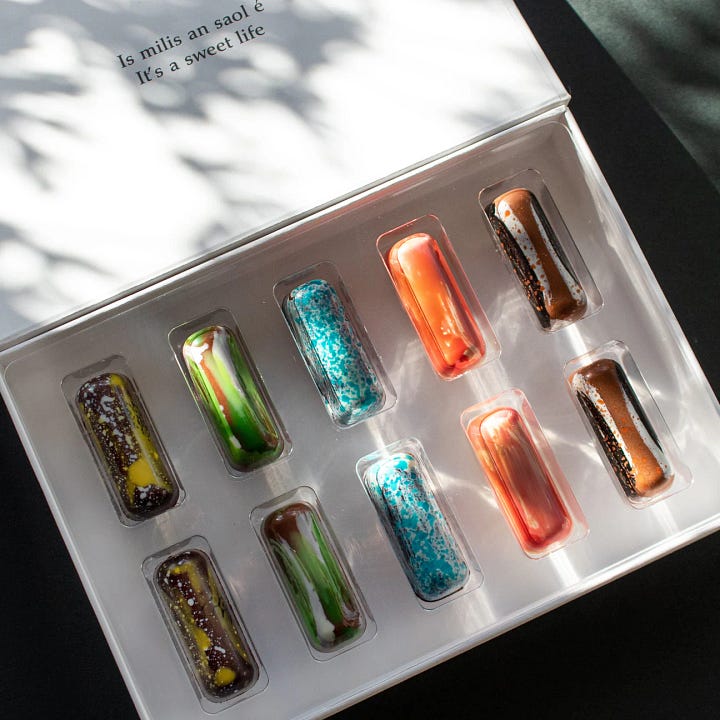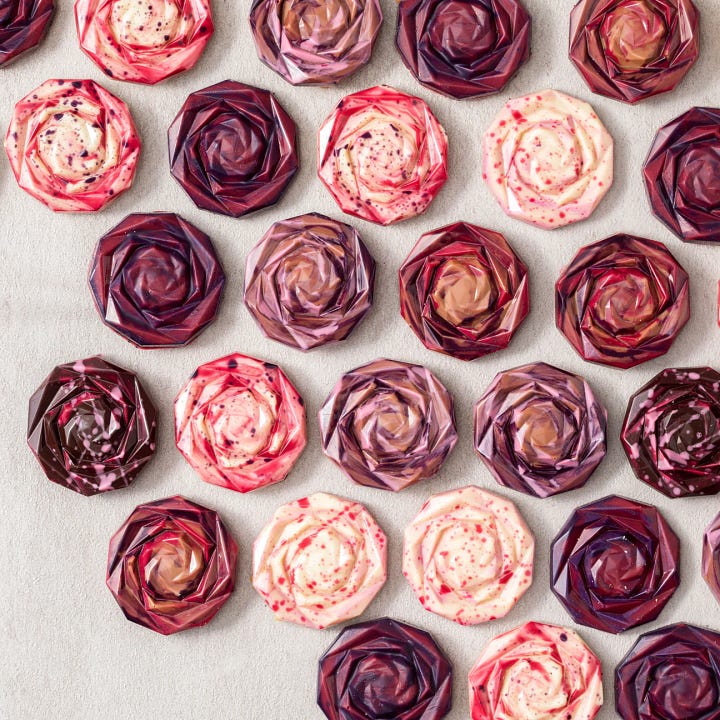♻️ Save Your Wardrobe - Save the Planet! with LVMH Innovation Award Winner Hasna Kourda
Come with us as we explore the facets of deconstructing a linear business model to build a circular fashion ecosystem with Tunisian entrepreneur Hasna Kourda.
Hello Tech Powered Luxury listener, and now reader!
🎙️ This week, we are thrilled to bring you an exclusive interview with Hasna Kourda, the award-winning Tunisian entrepreneur, founder of Save Your Wardrobe. Hasna is tackling some of the most complicated issues in the fashion industry: the creation of a circular business model, facilitating care and repair to increase a product’s lifecycle.
🌟 Are you new here? Welcome to our amazing community - keep reading to discover everything about Tech Powered Luxury, our Community Rewards and how this newsletter came to life.
✨ I’m Beatriz Barros and I’m very excited to have you reading us today!
👀 TL;DR
Hasna Kourda’s upbringing in Tunisia shaped her vision to solve one of the biggest issues in the fashion system: turning a linear business model into a circular one.
Going from “production to consumption to waste” into “production to consumption to repair and recycle to a new production” is no easy feat. There are several external components that influence our purchasing drivers and the system demand creation. Becoming aware of them is the first step into changing them.
Not everything is lost. Hasna is bridging the gap and distributing the responsibility between brands and consumers when it comes to managing a product’s lifecycle. There are other initiatives and players who are also creating a more sustainable future.
💎 Exclusive Question 💎
Who has been your most unexpected mentor, and what did they teach you?
“Mentorship encompasses various aspects of life, and like a Swiss Army knife, we need multiple mentors to address our diverse needs.
My most unexpected mentor has been failure.
Failure forces reflection, teaching valuable lessons about oneself, the industry, and others. It reveals hidden strengths and areas for improvement, shaping resilience, adaptability, and perseverance. Through failure, we learn to navigate challenges, innovate, and grow in ways success alone could never provide.
It has been an invaluable teacher, offering profound insights and growth opportunities essential for long-term success and personal development; enabling us to reach greater heights, receive globally recognised awards such as the LVMH Innovation Grand Winner Award, and win the validation of global leaders like Tim Cook.”
♻️ Where does circularity begin?
Regardless of where we look, we are living in very polarized times.
On one hand, we have ultra-fast fashion giants such as SHEIN and Temu, who have developed a business model that is dangerous and harmful on so many levels —economic, environmental, and social. These brands prioritize speed and low cost above all else, often at the expense of fair labor practices and environmental sustainability. Their rapid production cycles and constant release of new items encourage a throwaway culture, where garments are quickly discarded in favor of the next trend. This not only results in massive amounts of textile waste but also places enormous pressure on natural resources and contributes significantly to carbon emissions.
On the other hand, also because we really have no other option, we see a growing number of fashion and luxury brands embracing the principles of a circular economy, focusing on longevity, repairability, and recycling.
A lot of attention often goes to the supply chain and sale aspects of the product lifecycle, meaning that the after-sales impact often goes overlooked, leaving the responsibility of what to do with an item after it’s been bought in the sole hands of consumers.
“What I've realized is that everybody was looking at the supply chain and if things were produced in an ethical way or not, but nobody was looking at post purchase. That's when I decided to spend some time building a business model, learning about the problem, and understanding its ramifications.”
We might even discuss and analyse the growth of resale as a consequence of increased awareness of sustainable practices - but to a certain extent, this is also an easy way to pass on to the next person on Vestiaire Collective or Vinted, the responsibility of where a product will eventually end up.
But what happens to the item you bought, after the person you sold it to doesn’t want it anymore? Often, the best alternative is donating. But is it really?
“The typical journey of an item that, let's say, starts from you decluttering your wardrobe: You have the bright idea to go to the charity shop and give them a bag. What happens from the moment this bag is within the hand of charity shops? It gets to some sorting facilities, whether they are local in the UK or abroad, and those sorting facilities will divide them into several tiers, so the best ones will stay in the country and will be sold in the charity shop that you've dropped your item in.
Some of them will go abroad, whether in Eastern Europe or North Africa, to the closest offshore sorting facilities, and Tunisia actually is one of the biggest in the Mediterranean. We have several harbors, and I've seen it firsthand how those items were sorted.
I can tell you it's a very, very ugly sight. Some of them can reenter the Tunisian market. Some of them will be sent to other African countries.
And then the majority will be burnt, ‘accidentally’ burnt.
In Tunisia, twice or three times a year we see a big massive fire happening in warehouses that are ‘accidental’, but the reality of things is that they are incinerated because there’s no way you can dispose of them in a sustainable or environmentally-friendly way.”
Consumers most times are not even aware of this - Aoife McNamara is an Irish designer tackling this issue. We featured here a couple of weeks ago what she’s doing to raise awareness on what happens on the global South, and the direct impact of massive consumption on the lives of people who endure the consequences of our throwaway culture.
And even if we are aware of what actually happens when we discard something we’re not going to wear anymore, what can we actually do about it?
It’s useful to take a step back to start to understand the many driving forces behind the mess we find ourselves in.
Economically, a whole system is fed on driving consumption, regardless of the price tag. Never in a brand you’ll present a sales forecast that decreases year on year. At least not on a job that you plan on keeping.
Margins need to be not only respected, but constantly improved. This means that low-quality materials, fabrics that are not natural, components from lining to dyes that are not biodegradable, 9 out of 10 times will be chosen over the best option for the planet.
But if brands are selling, then it means people are buying.
Sort of. Let’s not forget how overproduction affects the fashion system and how still nowadays we close an eye to all the unsold inventory - not to mention the massive amount of products that gets destroyed because they are not perfectly well-made.
Add to this the social context in which we find ourselves in and the role that fashion plays in how we relate to our surroundings: it’s has always been a sign of status, a way to communicate to the external world who we are, and to fit within a community.
Which was all so fine back in the day when trends had a much longer lifecycle, allowing you to still be fashionable and relevant without having to buy a new item every week.
Social media has had a massive impact on how we consume trends, on the way we see ourselves and especially the way we want to be seen.
Want to add some more spice to this messy mix? Even if we wanted to recycle the items that we no longer want to keep, how many of them are actually recyclable?
Very few. Take a moment to look at the composition of your clothes. Now do a 5 minute research on how difficult it is to separate fibers that are mixed with plastic, and how much you can really save from them. Not so fun anymore.
❗️ Please send help?
Not everything is lost, and there are ways we can start addressing some of these issues. It’ll take government regulamentation and strong leadership in every step of the product lifecycle. To that point, as Hasna points out, “leadership is absolutely crucial to see not just on the short term, but also the long term relationship with producers and with manufacturers.”
There are innovators such as Hasna herself who are bridging the gap between consumers and brands, and educating both ends as to find a way to create a business model based on circularity that is sustainable for all parties involved.
“We are the moderator, the middle person between the consumer and the brand they are purchasing from.
People were requesting more involvement from the brands they were purchasing from. And with all those data points, we came to the brand and told them,
‘Listen, this is what the market is requesting. This is where we are now, and this is where you are. Let's try to do something together and explore what is the future of the fashion industry, that is not necessarily linear or is not necessarily built on purchasing again and again and again.’
And then we launched with Zalando in 2021. We then launched with Hugo Boss. And, shortly after that, we got the LVMH Innovation Award.
What we are bringing to the table is this platform that digitizes the whole experience to make it more convenient, to make the price [of repair] a little bit cheaper or maybe subsidized by having a brand collaborating on it.”
Other industry movements who can push us closer to reconciliation with a more respectful approach to the current social and environmental challenges we’re facing?
🪪 Digital Product Passports
In a nutshell, ideally they represent a significant step towards creating a transparent and sustainable fashion ecosystem. These digital records should contain detailed information about a product's materials, production processes, and lifecycle, providing consumers with the data they need to make informed choices.
They could also facilitate the recycling and repurposing of garments by detailing how each component can be processed at the end of its life. To make marketers happy, there are a myriad of ways in which you can use DPPs to engage and deeply connect with the consumer, driving loyalty and increasing the customers’ lifetime value.
Check out what Aura Blockchain Consortium has been doing. They’re not alone: EON, The ID Factory and Arianee are some of the other players engaged in the creation of digital product passports, with real case studies that range from increasing sustainable practices to improving customer relationship management.
Want to know more? Let me know below.
🎁 Community Rewards
For our beloved community this week we are offering a 20% voucher for Grá Chocolates using code TechPoweredLuxury20*.




Grá Chocolates, founded by award-winning pastry chef Gráinne Mullins, is known for its exquisite, hand-crafted confections. Each chocolate is meticulously made using high-quality, ethically sourced ingredients such as Valrhona Chocolate and Casa Luker cocoa butter, combined with the finest Irish dairy produce.
The process of creating these chocolates takes three days as each one of them is meticulously made and painted by hand, with signature fillings that change with the seasons, reflecting Ireland’s rich larder.
Want to know more? Listen to one of our early episodes featuring none other than Gráinne Mullins herself in the link below.
*Apply the code TechPoweredLuxury20 on checkout for 20% off your purchase on grachocolates.com. No minimum order value. Valid from July 2nd until July 17th, 2024.
🎙️ Upcoming Conversation: Una McGurk, founder of Seoulista Beauty
We’re back to our normal schedule.
Tune in next Tuesday for an episode with none other than Seoulista Beauty founder, Una McGurk. Back for the second time at Tech Powered Luxury, Una McGurk has carved a unique space in skincare, showing how science can nurture beauty to create a routine that is truly sustainable and efficient.
See you next week,
💫 Who are we and what led us here today?
🎙️ Launched as a podcast on November 1st 2022 by Ashley McDonnell, Tech Powered Luxury has since nurtured a vibrant community of experts passionate about the evolving synergy between technology and luxury. We have reached over 20 million people through the podcast, social platforms and media, and have hit +500K downloads.
🎁 Every week we are bringing Community Rewards to our subscribers. Stay tuned for discount codes, mentorship sessions and so much more!
💡 With over 60 episodes live across podcast platforms and MBA-worthy content - especially considering that Tech Powered Luxury is also taught to executive MBA and master students in business schools around the world -, we’re launching Season 4! We’re moving from an audio podcast to a full-blown show, with all episodes recorded in-person and available to watch (as well as listen).
📩 Not only that - in order to connect more deeply with our community and to curate essential insights for our readers, every Tuesday alongside a new podcast episode you'll receive an email brimming with exclusive content, key takeaways from the week's discussion and a sneak peek at upcoming interviews.
🪄 Our weekly newsletter is curated by Beatriz Barros, a seasoned expert in luxury and technology based in Milan, Italy. A dedicated collaborator of Tech Powered Luxury, Beatriz applies her expertise as a Fashion & Luxury Business Consultant at Retex—Italy's forefront company known for integrating strategic acumen with operational excellence to solve complex retail-oriented projects for fashion & luxury brands. Additionally, she educates aspiring professionals at Polimoda, renowned for its focus on Fashion Design & Business in the vibrant city of Florence, Italy - also where she first met Ashley during one of her lectures on the future of luxury: a match made in academic heaven. 🌈



Great to see more attention on DPP. We’re seeing a big uptick in brand leaders asking for support in developing a plan. Biggest challenge is ownership within the brand, anticipate significant increase in sustainability and CSR style roles within brands!